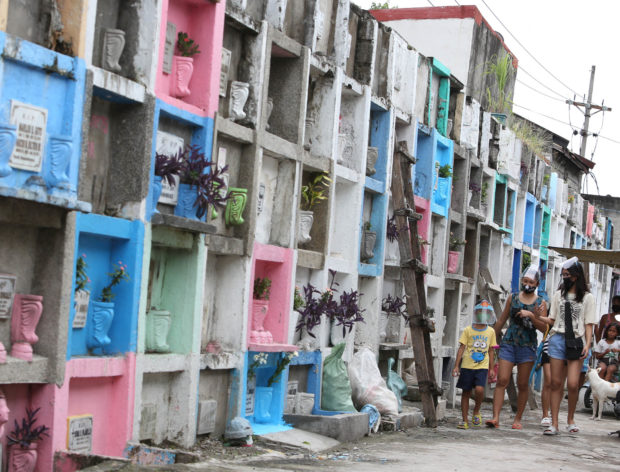Daily death toll from virus drops below 100

REMEMBERING A cemetery in Pasay City on Monday receives visitors paying respects to their departed relatives. Public cemeteries and private memorial gardens all over the country will be closed during the traditional “Undas” (All Saints’ Day and All Souls’ Day) to avoid mass gatherings and as a precaution against the spread of COVID-19. —MARIANNE BERMUDEZ
MANILA, Philippines — The daily death toll from COVID-19 fell below 100 for the first time since April, amid the continued decline in new infections in recent weeks.
Data from the Department of Health (DOH) showed that there were 1,170 deaths, or an average daily death toll of 69, for the period of Oct. 1 to Oct. 17.
But on Monday, the death toll rose to 86, including 30 who were previously tagged as recoveries, although this was still below 100.
More than a hundred people died of COVID-19 each day on average since April.
That month, 4,055 people succumbed to the disease, or an average of 135 each day.
Article continues after this advertisementThe death toll in May was 3,843, or a daily average of 124. In June it was 3,234, or 108 each day, and in July, 3,141, or 101 daily.
Article continues after this advertisementDuring the COVID-19 surge last August, as driven by the Delta variant, deaths peaked to 5,055 or a daily average of 163.
In September, the DOH reported 4,308 more deaths, or an average of 144 each day.
The death toll since the pandemic began in March last year has reached 40,761.
About 60 percent, or 24,806 deaths, occurred in the last six months alone or since April, amid the third wave of a surge in cases.
Virus case update
Despite the encouraging figures, the DOH noted that several regions still experienced “critical” hospital bed occupancy.
Of the country’s 17 regions, Zamboanga Peninsula remained classified at high risk. The DOH also continued to monitor the coronavirus situation in the Cordillera Administrative Region, Cagayan Valley, Davao, Central Luzon, Bicol, Caraga and the Bangsamoro Autonomous Region in Muslim Mindanao.
Nationwide, however, intensive care unit (ICU)-bed utilization was at a moderate 62 percent as of Monday. In Metro Manila, it was at 59 percent.
The average reported cases last week had gone down to 7,732, from 10,067 the previous week.
The DOH reported 6,943 new infections on Monday, the second straight day of daily cases being less than 7,000.
This brought the total cases to 2,727,286 since the start of the pandemic.
Monday’s bulletin showed 68,832 cases, the lowest since Aug. 5, with the majority, or 79.7 percent, being mild; 5.5 percent, asymptomatic; 8.42 percent, moderate; 4.5 percent, severe; and 1.9 percent, critical.
‘Judicious testing’
An expert defended the average 50,000 tests conducted daily, in response to claims that these tests were not enough.
Dr. Edsel Salvana, a member of the technical advisory group of the DOH, said the government had been conducting “judicious testing” on those who had symptoms.
“We do test those who have symptoms, those with exposure, but we don’t test people if they have no exposure or no symptoms because the yield [in results] is low,” he said at the Laging Handa briefing.
He added that there was the risk of turning out “false negative” results if the government went beyond judicious testing.
“From what we see, we know that the number of people testing positive is declining also because our positivity rate is going down at the same time. If the tests are insufficient but the positivity rate remains high, we will know that tests being conducted are really not enough,” Salvana said.
Of the 54,150 tests conducted on Saturday, 7,202 came out positive. This placed the country’s positivity rate at 13.3 percent, a slight drop of about 1 percent compared with last week.
‘Live with this virus’
Yet for all these signs of an overall decline in COVID-19 cases, the government warned that infections might still increase anew.
“Every time that we ease up our restrictions, mobility increases, and there really is a higher chance for the virus to spread. But we can prevent these by adhering to our minimum public health standards,” Salvana said.
He also noted that there were more vaccinations now, which, he said, meant that there was a “smaller chance” of coronavirus cases becoming severe.
According to data from the DOH and the National Task Force Against COVID-19, 27,996,002 Filipinos have been inoculated as of Oct. 17, with 34.3 percent, or 24,307,903 fully vaccinated.
“We have to live with this virus, we can’t just go into lockdowns every time because our countrymen are starving,” Salvana said.
Interior Undersecretary Jonathan Malaya said the public should continue observing health protocols.
“Let us observe discipline, let us not flock together, and let us always comply with minimum public health standards, such as the use of face masks and face shields,” he said.
—WITH REPORTS FROM INQUIRER RESEARCH INQ
For more news about the novel coronavirus click here.
What you need to know about Coronavirus.
For more information on COVID-19, call the DOH Hotline: (02) 86517800 local 1149/1150.
The Inquirer Foundation supports our healthcare frontliners and is still accepting cash donations to be deposited at Banco de Oro (BDO) current account #007960018860 or donate through PayMaya using this link.